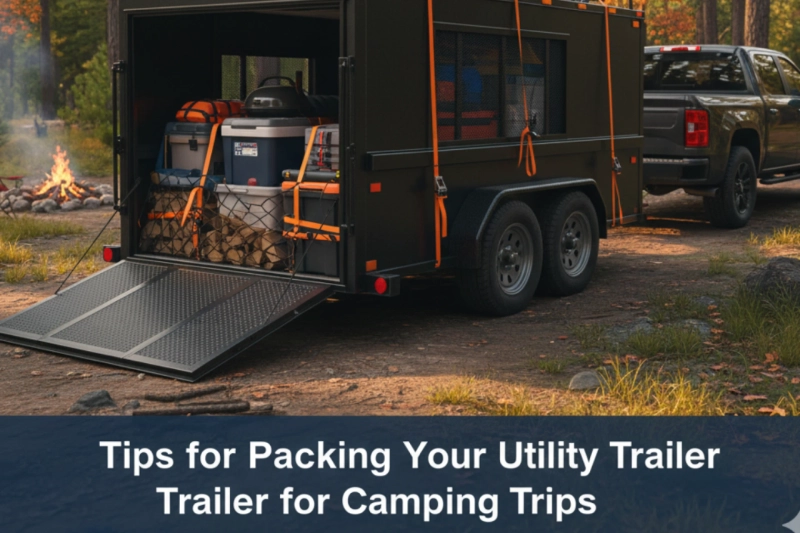Planning a camping trip involves more than choosing the perfect campsite—it also requires careful organization of your gear. Utility trailers for camping provide ample space to carry essential equipment, but packing them effectively is key to a smooth and enjoyable experience. Proper arrangement not only protects your items during transit but also maximizes space, accessibility, and safety.
1. Prioritize and Categorize Your Gear
Before loading, make a comprehensive list of all necessary items and categorize them by type:
- Camping Essentials: Tent, sleeping bags, camping stove.
- Kitchen Supplies: Coolers, utensils, portable grills.
- Outdoor Gear: Chairs, tables, lanterns, and recreational equipment.
- Personal Items: Clothing, toiletries, and first-aid kits.
Sorting items into categories ensures that high-priority gear is loaded in an accessible spot, while heavier or less frequently needed items can be stored further back or underneath.
2. Use Storage Containers and Bins
Rigid storage bins or waterproof containers are ideal for keeping your items organized. They prevent smaller objects from shifting and getting damaged during transport.
- Label each container according to its contents for quick identification.
- Stack bins strategically, placing heavier containers on the bottom and lighter ones on top.
- Use clear bins for easy visual access without having to unpack everything.
This method maintains order and reduces the time spent searching for essential gear at the campsite.
3. Distribute Weight Evenly
Proper weight distribution is crucial for safe towing and stability:
- Place heavier items over or slightly forward of the trailer axle to maintain balance.
- Avoid loading all heavy items on one side, which can cause swaying during transit.
- Keep frequently used items near the rear or top for easy retrieval without unloading the entire trailer.
Balanced weight helps maintain control, reduces strain on the towing vehicle, and minimizes the risk of trailer damage.
4. Secure Items with Straps and Tie-Downs
Loose items can shift or tip over during travel, creating hazards and potential damage.
- Use ratchet straps, bungee cords, or cargo nets to secure all containers and equipment.
- Anchor straps to trailer hooks or rails to hold items firmly in place.
- Double-check that straps are tight but not overly tight to avoid crushing fragile items.
Securing items also prevents rattling noises and makes towing smoother, especially on uneven terrain.
5. Protect Fragile and Sensitive Equipment
Camping trips often involve delicate gear like electronics, glassware, or cookware. Protect these items by:
- Wrapping fragile items in blankets, towels, or bubble wrap.
- Placing delicate containers in the center of heavier items for cushioning.
- Keeping electronics in waterproof bags or protective cases to guard against moisture.
Proper protection reduces the risk of breakage and ensures all essentials are usable upon arrival.
6. Keep Accessibility in Mind
Certain items need to be accessed quickly during setup or emergencies:
- Place tents, sleeping bags, and first-aid kits near the rear of the trailer for easy unloading.
- Keep frequently used cooking gear and outdoor tools within reach.
- Organize the trailer so that you can unload selectively without disturbing other items.
Accessibility planning saves time at the campsite and reduces the hassle of unpacking everything at once.
7. Utilize Trailer Covers and Tarps
Weather protection is critical when transporting camping gear:
- Use heavy-duty tarps or trailer covers to shield gear from rain, wind, and sun.
- Secure covers tightly with ropes or straps to prevent flapping during travel.
- Ensure ventilation to prevent moisture buildup inside covered areas.
Covering your trailer preserves the condition of your equipment, extending the life of your gear.
8. Perform a Safety Check Before Departure
Before hitting the road, inspect the trailer and load:
- Verify that the hitch, lights, and brakes are functioning correctly.
- Ensure all items are properly secured and covered.
- Check tire pressure and wheel alignment for safe towing.
A final safety check prevents accidents, protects your gear, and ensures peace of mind throughout the trip.
Frequently Asked Questions (FAQs)
1. Can utility trailers carry all types of camping gear?
Yes. They can transport tents, coolers, recreational equipment, and personal belongings efficiently.
2. How should heavy items be positioned in the trailer?
Heavier items should be placed over the axle or slightly forward and distributed evenly to maintain balance.
3. Are storage bins necessary for trailer organization?
While not mandatory, bins help protect items, reduce movement, and simplify unloading at the campsite.
4. Can trailers be left uncovered during transport?
It is not recommended. Covers protect against weather, dust, and debris that could damage gear.
5. How do I prevent gear from shifting while driving?
Secure all items with straps, tie-downs, or cargo nets, and check that nothing is loose before departure.
Conclusion
Packing utility trailers for camping requires strategic planning, organization, and attention to safety. Categorizing gear, distributing weight properly, securing items, and using protective containers or covers all contribute to a more efficient and enjoyable trip. Accessibility, weather protection, and routine safety checks ensure that your equipment arrives in perfect condition, making the camping experience stress-free and enjoyable. By following these tips, outdoor enthusiasts can fully leverage their utility trailer, making each adventure both organized and memorable.



